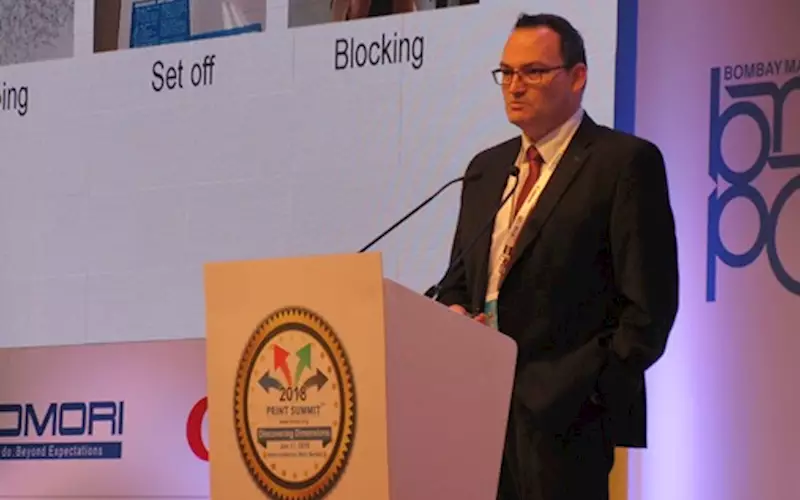BMPA's PS 18: Looking to invest in HUV / LED UV
The theme of Siegwerk’s Thomas Glaser presentation was: HUV / LED UV - reality or myth?
Conventional UV curing, which uses mercury lamps as a UV source, has existed for quite a few years. Now newer types of UV curing – namely LE-UV, also known to Komori users as HUV, and LED-UV, are currently leading the way.
17 Jan 2018 | By Sujith Ail
The main draw of UV curing is that ink dries instantly, saving on storage space and time and allowing work-and-turn or finishing to be completed immediately.
The main advantage, according to Thomas Glaser for a competitive market like India is the short-turnaround. And so, now it is possible to dry certain offset material within seconds.
Glaser spoke about the one reason conventional UV is seen as a less enticing prospect is the fact that the mercury lamps the technology uses are likely to be phased out of the print industry in the years to come.
He explained, conventional UV gives off a large amount of ozone, which has to be ducted out of any print works. LED UV completely eliminates powder spray so the machinery and the print works become completely decontaminated from powder.
Also, the lamp life is substantially longer than that of a conventional UV lamp, which printers have to continually change.
In addition, Glaser pointed out the quality advantage. These include: higher contrast of image; brighter colour; high mechanical resistances; high ink coverage; high gloss; non absorbent substrates possible; and differentiation possibility (mat gloss, drip off…)
This means the technology can open up new revenue streams by enabling printers to print on plastics, foils and substrates with a high surface tension. This opens up potential opportunities including loyalty cards and stickers and effects such as UV varnishes and high builds.
Glaser said, inmould labels (IML) use LED UV low migration systems.
The benefit of LED UV according to Glaser is that the UV drying system is cheaper and the lower heat/energy requirement of LED makes it much safer and therefore a more attractive process.
He shared numbers about how the LED UV installation base across the world in the large-format arena and the offset arena. The only deterrent among users is, many believe the inks are expensive and the systems require photo-initiators.
However, there have been huge advances in the technology; low-migration inks and process systems that make LED UV significantly more attractive.
Glaser affirmed that tied with the lower operating costs, fewer emissions, low odour and much lower fire risk make LED UV at least a consideration for new investment.
Demystifying LE-UV/HUV
Unlike conventional UV curing, neither LE-UV/HUV nor LED-UV technology use mercury lamps as a UV source
In LE-UV, LE stands for ‘low-energy’ and refers to the power of the lamps compared with standard mercury lamps
In Komori’s HUV technology, the H stands for ‘highly reactive’, which refers to the nature of the inks. They are more sensitive, so don’t need as much energy as standard UV inks and can be used with lower-output lamps
Both HUV and LE-UV use lamps that are doped with iron. These lamps don’t emit the shorter UV wavelengths that generate ozone, and as a result obviate the need for ozone extraction. Additionally, as they consume less energy they produce less heat, so require less cooling, which helps reduce the power consumption of the UV curing system
In LED-UV the LED stands for light-emitting diode. The UV they put out is in a much narrower band of wavelengths that don’t generate ozone. LEDs are more efficient at converting electricity to electromagnetic radiation than conventional bulbs, however they do generate heat, so heat extraction is still needed














 See All
See All